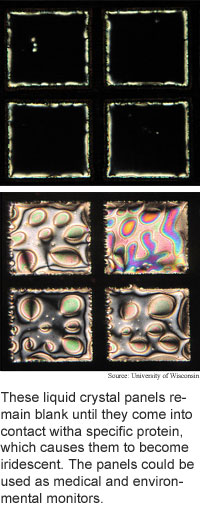
Liquid crystal IDs pathogens
By
Kimberly Patch,
Technology Research NewsMany research teams are working to make portable sensors that are capable of detecting biological substances like toxins, bacteria and viruses outside the laboratory.
One challenge in making such devices is finding a way for sensing molecules to indicate the presence of target molecules in a way that can be conveyed to the larger world.
Researchers from the University of Wisconsin at Madison have made a portable sensor that conveys results visually.
The sensing portion of the device is made from a mix of phospholipids, which are fatty molecules commonly found in cell membranes, and the liquid crystal commonly used in computer screens. When biomolecules present in liquid flowing past the detector bind to the detector's phospholipid molecules, the liquid crystal becomes brighter, and shows a pattern corresponding to the orientation of the molecules.
The setup enables very small detectors that do not require power sources. The design could lead to low-cost, no-power, portable, real-time biomolecule detectors, according to Nicolas Abbott, a professor of chemical and biological engineering at the University of Wisconsin at Madison. "It could be used to monitor for the presence of approaching toxins or pathogens in a flowing stream," for example, he said.
The researchers hit upon the design when they realized that liquid crystal could be used to amplify, or detect, a biomolecule binding to a phospholipid. Phospholipids are a biological type of liquid crystal, said Abbott. Because liquid crystal exists in both the biological and electronic worlds, it seemed natural to use the substance to create an interface between the two worlds, he said.
The researchers constructed the sensor by putting liquid crystal into tiny metal grids designed for electron microscopy. This made for a flat, stable liquid crystal surface on which to assemble the phospholipids. The liquid crystal molecules, which are shaped like rods, bind with the phospholipids in such a way that the liquid crystal molecules line up vertically, which makes the liquid crystal dark under polarized light.
When a biological module that is strongly attracted to the phospholipid is present, the phospholipid binds to the biological molecule and releases the liquid crystal, causing it to change orientation, which changes its appearance. In the researchers' experiments, these changes occurred in 30 to 90 minutes.
The detector's phospholipid's are chosen to detect specific biomolecules.
The researchers are currently working on sensor configurations that detect protein toxins and viruses, said Abbott.
Further down the road, the design could be used to detect medical conditions requiring medication, and release drugs when needed, said Abbott. "It might be possible to integrate a response like the release of a drug into the design of the biosensor," said Abbott.
The changes to the liquid crystal can also be measured electrically, which means the sensors could be integrated into electronic devices, according to Abbott.
Abbott's research colleagues were Jeffrey M. Brake, Maren K. Daschner and Yan-Yeung Luk. The work appeared in the December 19, 2003 issue of Science. The research was funded by the National Science Foundation (NSF) and the National Institutes of Health (NIH).
Timeline: Unknown
Funding: Government
TRN Categories: Biotechnology; Materials Science and Engineering
Story Type: News
Related Elements: Technical paper, "Biomolecular Interactions at Phospholipid-Decorated Surfaces of Liquid Crystals," Science, December 19, 2003
Advertisements:
August 25/September 1, 2004
Page One
Selective shutdown protects nets
Tools design DNA-nanotube logic
Five photons linked
Liquid crystal IDs pathogens
Briefs:
Photosynthesis drives solar cell
Hybrid nanowire makes transistor
Nanocrystals spark efficient LEDs
Nanotubes make fluid filter
DNA copier uses little power
Method makes stronger steel

News:
Research News Roundup
Research Watch blog
Features:
View from the High Ground Q&A
How It Works
RSS Feeds:
News
Ad links:
Buy an ad link
| Advertisements:
|
 |
Ad links: Clear History
Buy an ad link
|
TRN
Newswire and Headline Feeds for Web sites
|
© Copyright Technology Research News, LLC 2000-2006. All rights reserved.